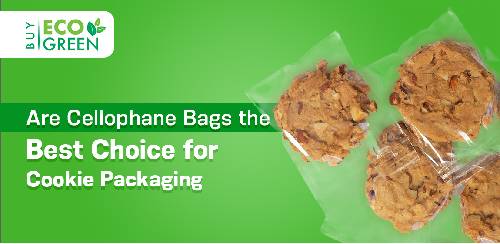


Explore why cellophane cookie bags may be your ideal packaging: freshness, presentation, sustainability, and tips from eco-conscious packaging experts.

When sharing homemade cookies or selling gourmet treats, packaging does more than hold your product—it tells a story. Cellophane bags for cookies offer a compelling blend of transparency, cost-effectiveness, and eco-friendly appeal. With 70 % of consumers citing packaging appearance as a key purchase driver, clear cello bags can showcase your cookies’ design while appealing to environmentally aware buyers.
Yet, not all cellophane bags are created equal. Some are highly moisture‑resistant and food‑safe, while others may absorb moisture or tear easily. In projects ranging from indie bakeries to bulk party favours, choosing the right cellophane cookie bag is vital to maintain freshness, visual charm, and sustainability.
Cellophane bags are transparent packaging made from regenerated cellulose, a biodegradable material derived from wood pulp, cotton, or other plant sources. Often used for a variety of products, including cookies, these bags have gained popularity due to their sustainable properties. Unlike plastic, cellophane bags break down naturally over time, making them an environmentally friendly choice. They offer clear visibility, showcasing the product inside, which is a key benefit when packaging cookies or other baked goods.
Cellophane bags for cookies are designed to provide a sleek and attractive presentation, while also offering essential benefits such as moisture resistance and air permeability, which help keep baked goods fresh. This type of packaging is an excellent choice for eco-conscious bakers or businesses aiming to reduce their carbon footprint while maintaining product freshness.
Cellophane bags are a popular choice for packaging cookies, as they help maintain freshness for an extended period. While they are not as airtight as some plastic packaging options, they offer moisture resistance and allow a small amount of air flow, which is vital for preserving the texture of cookies. This balance makes them suitable for short-term storage or transport, especially when cookies are consumed within a few days.
For maximum freshness, it’s essential to ensure the cellophane bags are appropriately sealed. Resealable cellophane cookie bags can be an excellent option for preserving freshness, as they allow for easy closure. While not as long-lasting as vacuum-sealed packaging, cellophane bags are a great, eco-friendly solution for maintaining moderate freshness.
There are several types of cookie packaging options, each with distinct advantages depending on the needs of the baker or business. The most common packaging materials for cookies include cellophane bags, plastic containers, resealable cookie bags, and paper-based options.
Cellophane cookie bags are a popular choice for many reasons. They offer a clear, visually appealing presentation and are often used for single or small quantities of cookies. In contrast, plastic packaging may provide a tighter seal, extending the freshness of the cookies for longer periods, but it is less environmentally friendly than cellophane. For eco-conscious bakers, options like paper bags or cardboard boxes are also viable alternatives. Resealable bags are convenient for keeping cookies fresh while offering a great customer experience.
While cellophane was once a widely popular packaging material, its use has declined over the years due to several key reasons. One of the primary factors is its relatively high cost compared to modern plastic alternatives. Plastic bags are more affordable, durable, and easier to manufacture in large quantities. Additionally, cellophane’s production process can be more environmentally taxing, as it requires more energy and chemicals.
Despite these drawbacks, cellophane bags for cookies have made a comeback in recent years due to the growing demand for eco-friendly packaging solutions. Unlike plastic, cellophane is biodegradable, making it a preferred choice for businesses looking to align with sustainability values. For short-term packaging or niche markets, such as homemade goods or gifts, cellophane remains a desirable option due to its natural look and eco-conscious appeal.
Yes, cellophane bags are safe for food packaging, including cookies. They are made from regenerated cellulose, a plant-based material, which is non-toxic and compliant with food safety standards. Cellophane provides a barrier against moisture, dust, and contamination, which helps to protect the freshness of cookies and other baked goods.
It’s essential to note that while cellophane is food-safe, it must be stored and handled correctly to ensure product safety. Look for cellophane bags specifically labelled as food-grade to ensure they meet industry standards. As an added benefit, cellophane is biodegradable, making it a more environmentally friendly choice than many plastic options.
Know more https://www.buyecogreen.com.au/cellophane-bags-best-cookie-packaging
